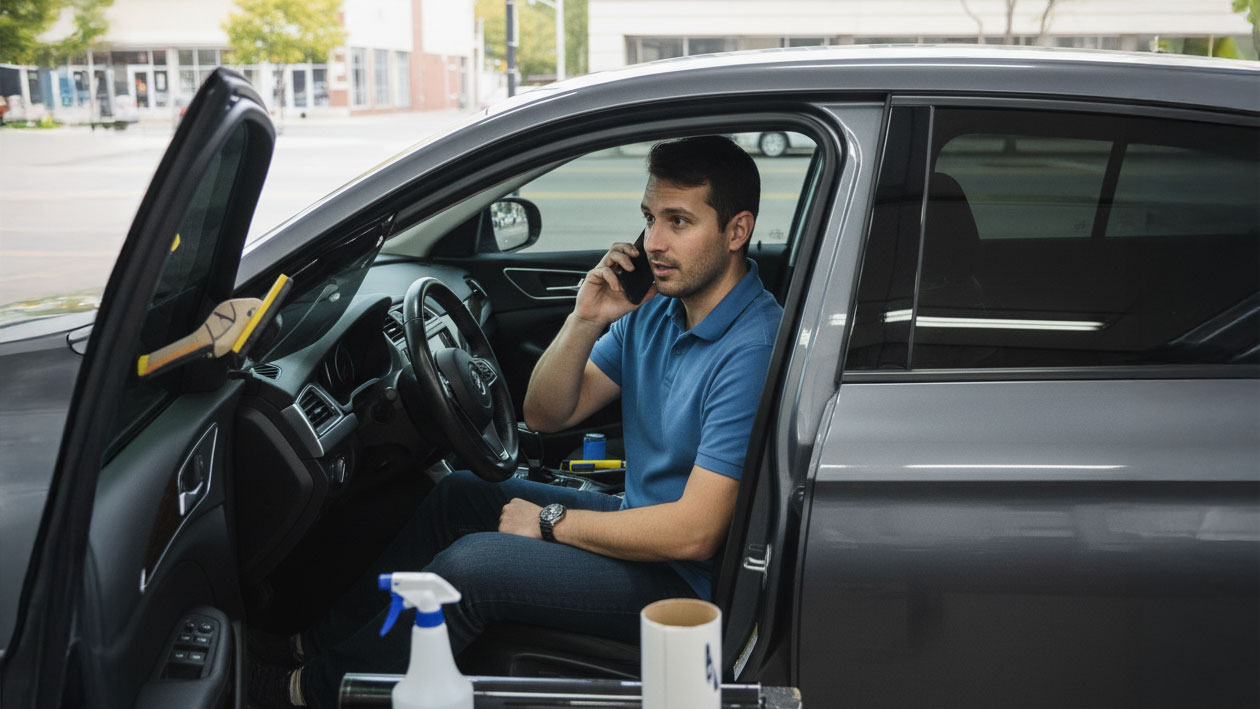
Yes, certain types of window tint can block electronic signals. Metallic-based tints are the primary cause of interference with mobile phone, GPS, and radio signals due to their metal particle content. However, modern non-metallic options like ceramic and carbon tints are specifically designed to be signal-friendly, allowing you to get the benefits of tint without dropped calls or lost navigation.
Which Window Tints Block Signals?
Metallic window tints are the only type known to interfere with electronic signals. Tints made from ceramic, carbon, or dye do not contain metal and will not disrupt your phone, GPS, or radio reception. For guaranteed connectivity, choose a ceramic or carbon film.
| Feature | Metallic Tint | Carbon Tint | Ceramic Tint |
|---|---|---|---|
| Phone Signal (4G/5G) | High Interference | No Interference | No Interference |
| GPS Navigation | High Interference | No Interference | No Interference |
| Radio (AM/FM/Satellite) | Potential Interference | No Interference | No Interference |
| Heat Rejection | Good | Very Good | Excellent |
| Cost | $ | $$ | $$$ |
Best Choices for Your Needs
Best for Maximum Connectivity: Ceramic Tint offers the best heat rejection with zero signal interference, making it the top choice for modern, tech-heavy vehicles. If you rely heavily on navigation apps, hands-free calling, or streaming services, ceramic tint provides peace of mind alongside superior performance.
Best All-Round Performance: Carbon Tint provides excellent heat rejection and a stylish matte finish without interfering with electronics, offering a great balance of price and performance. It’s particularly popular among Australian drivers who want quality without the premium price tag of ceramic.
Use with Caution: Metallic Tint. While effective at rejecting heat and often the most affordable option, the metal particles can block or reflect the radio frequency signals that your devices rely on. Consider this only if you rarely use electronic devices in your vehicle.
How to Choose the Right Tint for Your Car
Ask yourself these three questions to find your perfect tint:
- Is uninterrupted GPS navigation critical for you? (Yes/No)
- Do you often drive in areas with weak mobile service where every bar counts? (Yes/No)
- Do you rely on satellite radio or have an in-glass radio antenna? (Yes/No)
Your Action Plan
If you answered YES to any question: Your best choice is a Ceramic or Carbon window tint. These non-metallic films provide superior performance without the risk of signal interference. Given Australia’s vast distances between cities and variable mobile coverage in regional areas, maintaining strong signal reception is crucial.
If you answered NO to all questions: You could consider a metallic tint, but be aware of the potential for signal disruption, especially in rural areas or with future technology upgrades.
Why Do Metallic Tints Interfere With Signals?
Metallic window tints contain microscopic metal particles that are excellent at reflecting heat—perfect for Australia’s harsh sun. Unfortunately, these same particles can also reflect and absorb the radio frequency (RF) waves used by your mobile phone, GPS, and radio. This creates a phenomenon known as a “Faraday cage” effect, which weakens or blocks signals from entering or leaving your car.
Think of it like this: the metal particles in the tint act like a shield. While they’re blocking harmful UV rays and heat (which is brilliant), they’re also blocking the invisible radio waves your devices need to communicate with mobile towers and satellites.
Key Takeaway: It’s not the tint itself, but the material inside it. Metal blocks signals; ceramic and carbon do not. Always confirm the material composition with your window tint installer before making a purchase.
This interference is often worse in areas with weak mobile coverage to begin with. In Sydney or Melbourne’s CBD with strong signals, the effect may be minimal, but driving through the Blue Mountains or along the Great Ocean Road, it could be the difference between having service and having none.
What to Do If You Suspect Your Tint is Blocking Signals
Step 1 (Verify): Contact your installer and ask for the exact make and model of the tint film used on your vehicle. Reputable Australian installers should provide this information readily and may even have signal-testing results available.
Step 2 (Test): Park in an area with a known strong signal—perhaps near a Telstra, Optus, or Vodafone tower. Roll down your windows and test your phone’s data speed and call quality. Roll them up and test again. A significant drop indicates potential interference.
Step 3 (Resolve): If you confirm you have a metallic tint causing issues, the only definitive solution is to have it professionally removed and replaced with a non-metallic film like ceramic. While this represents an additional cost, consider it an investment in staying connected, especially important for those who rely on their vehicles for work or frequently travel through regional Australia.
Making the Right Choice
Choosing the right window tint doesn’t have to be complicated. By understanding the simple distinction between metallic and non-metallic tints, you can enjoy all the benefits of window tinting, reduced heat, UV protection, enhanced privacy, and improved aesthetics, without sacrificing your connection to the digital world.
For most Australian drivers, especially those who value reliable connectivity for safety and convenience, ceramic or carbon tints represent the smart choice. They might cost a bit more upfront, but the peace of mind knowing your navigation won’t fail on an unfamiliar country road or your calls won’t drop during important conversations makes them worth every cent.
Remember: always discuss your connectivity needs with your tinting professional before installation. A quality installer will help you choose a film that meets both your performance expectations and your connectivity requirements, ensuring you stay cool, protected, and connected on every journey.

